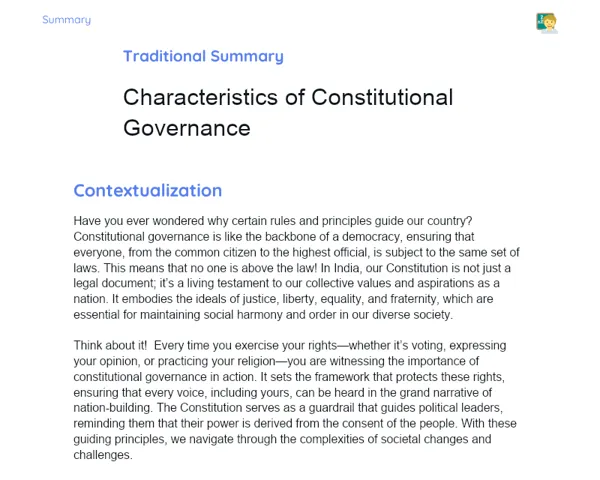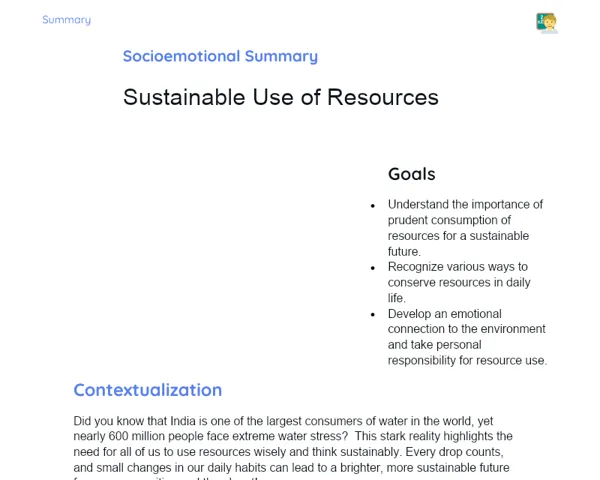Objectives
1. Understand the concept of social inclusion and its significance in society.
2. Identify various efforts and initiatives aimed at promoting social inclusion in different communities.
3. Analyze the impact of these efforts on marginalized groups and society as a whole.
4. Develop a critical perspective on the challenges and opportunities in achieving true social inclusion.
Contextualization
In our vibrant and diverse India, social inclusion plays a pivotal role in ensuring that everyone, regardless of their background, has access to opportunities. From bustling cities to quaint villages, we share a society rich in cultures, languages, and identities. Yet, many face barriers that keep them on the fringes. By examining the efforts made for social inclusion, we not only celebrate our differences but also find ways to bridge the gaps, creating a more equitable and just world. So, let’s embark on this journey together and explore how we can contribute to an inclusive society! 🌍✨
Important Topics
Community Mobilization
Community mobilization refers to the process of engaging and empowering individuals and groups within a community to advocate for their own rights and interests. This strategy often involves bringing together local leaders, volunteers, and residents to form committees or groups that can identify issues affecting their community and develop solutions. In the context of social inclusion, mobilization plays a crucial role as it helps marginalized groups find their voice, encouraging active participation in decision-making processes that affect their lives. The essence of this component lies in fostering a sense of belonging and ownership, which is vital for building an inclusive society where everyone feels valued.
-
Empowerment: Community mobilization empowers individuals, giving them the tools and confidence to express their needs and desires. By creating spaces for dialogue, communities can address issues such as discrimination, poverty, and access to resources.
-
Collective Action: Mobilized communities often work together to tackle common challenges. This collective approach fosters solidarity and can lead to more sustainable solutions that truly reflect the community's aspirations.
-
Sustainability: When communities are actively involved in the change process, the impact is often more lasting. People are more likely to uphold and sustain initiatives they helped create, ensuring social inclusion efforts endure over time.
Inclusive Policies
Inclusive policies are frameworks and guidelines set by governments and organizations aimed at ensuring equal opportunities for all individuals, regardless of their background. These policies can range from education and employment schemes to health care access and anti-discrimination laws. When implemented effectively, inclusive policies can bridge gaps and remove barriers faced by marginalized groups, providing them with the necessary support to thrive. The importance of this component cannot be overstated, as it lays the groundwork for systemic change, enabling society to become more equitable and just for everyone.
-
Equity: Inclusive policies are designed to level the playing field, ensuring that disadvantaged groups receive the resources and support required to overcome systemic barriers. This understanding of equity is crucial for social inclusion.
-
Representation: Policies aimed at inclusion often promote the representation of diverse groups in decision-making processes. This ensures that the voices of those who are typically marginalized are heard and considered.
-
Social Justice: By addressing the root causes of inequality, inclusive policies contribute to broader social justice efforts. They challenge the status quo and push society towards a more just framework for everyone.
Cultural Sensitivity
Cultural sensitivity refers to the awareness and understanding of different cultural practices, beliefs, and values. In a diverse country like India, recognizing and respecting cultural differences is vital for promoting social inclusion. Culturally sensitive practices help create an inclusive environment by ensuring that individuals from various backgrounds feel accepted and valued. Training and education programs that emphasize cultural sensitivity can drastically improve social relations and reduce discrimination, making it essential for fostering harmonious coexistence in our multicultural society.
-
Awareness: Being culturally sensitive involves acknowledging and understanding the unique backgrounds and experiences of different groups. This awareness helps reduce stereotypes and promotes mutual respect.
-
Inclusive Practices: Culturally sensitive approaches in education, healthcare, and community engagement facilitate interactions that respect individuals' cultural identities, fostering a more welcoming environment for all.
-
Conflict Resolution: Understanding cultural differences can play a vital role in resolving conflicts. Culturally sensitive communication fosters empathy and dialogue, enabling constructive discussions that lead to conflict resolution.
Key Terms
-
Social Inclusion: The process of improving the terms of participation in society for people who are disadvantaged or marginalized.
-
Community Mobilization: The act of bringing together people in a community to work towards a common goal or to advocate for social change.
-
Inclusive Policies: Regulations and frameworks that aim to provide equal rights and opportunities for all individuals, particularly those from marginalized groups.
-
Cultural Sensitivity: The understanding and appreciation of cultural differences and practices, which is essential for fostering acceptance and cooperation in a diverse society.
For Reflection
-
What role do you think community mobilization plays in advocating for the rights of marginalized groups in your locality?
-
How can inclusive policies be improved to better serve diverse communities, particularly in India?
-
Reflect on an instance where cultural sensitivity made a difference in resolving a conflict or misunderstanding. How can we promote such sensitivity in our daily lives?
Important Conclusions
-
Social inclusion is essential for creating an equitable society where everyone, regardless of their background, can thrive.
-
Community mobilization empowers individuals to advocate for their rights and fosters a sense of belonging.
-
Inclusive policies play a crucial role in leveling the playing field, ensuring all voices are heard and represented.
-
Cultural sensitivity promotes respect and understanding, which are vital for peaceful coexistence in our diverse nation.
-
Recognizing the challenges and opportunities surrounding social inclusion allows us to become active participants in creating positive change.
To Exercise Knowledge
Create a 'Social Inclusion Action Plan' for your community. Identify three specific actions you can take or promote to enhance social inclusion (like organizing an awareness campaign, starting a community dialogue, or helping to establish inclusive spaces). Present your plan in a creative format (like a poster, blog, or video) and share it with your family and friends to get their input!
Challenge
Find a local initiative or organization that works towards social inclusion. Attend a meeting or volunteer for a day. Document your experience and how it impacted your perspective on social inclusion. Share your learnings with your classmates in our next session!
Study Tips
-
Engage with local news stories related to social inclusion; try to analyze how these initiatives are impacting your community.
-
Discuss the concepts of social inclusion with family or friends to deepen your understanding and gain diverse perspectives.
-
Create flashcards for key terms and components related to social inclusion and quiz yourself regularly to reinforce your learning.



